If you love the Great Dane breed, then you already know that these are very large dogs. But what if you want a smaller version of Great Dane with the same temperament and personality traits?
Meet the Miniature Great Dane, another new addition to the canine world.
While Miniature Great Danes are cute and adorable dogs, however, they are the off-springs of two runts – which are sadly associated with many health problems. Moreover, they can be a consequence of a birth defect called dwarfism.
As such, the Miniature Great Dane is sadly prone to a wide range of health disorders and has a reduced average lifespan.
If you still want a smaller version of the Great Dane dog, read on to learn everything you need to know before adding one to your family.
Here, you’ll find all the facts and information you need to help you make your decision, including Mini Great Dane temperament, health, breeders and much more.
But first things first:
Table of Contents
What Is a Miniature Great Dane?
Miniature Great Danes are basically the Great Danes who are unable to attain the standard Great Dane size for one reason or another.
As mentioned earlier, the Mini Great Dane is normally a Great Dane dog that suffers from dwarfism or an off-spring of two runts. Therefore, these canines are smaller in size and do not grow up to be a standard-sized Dane.
The Miniature Great Dane is also known as a Mini Great Dane, Teacup Great Dane or Pocket Great Dane.
Although these dogs are not so tiny, they are smaller versions of the Great Dane, one of the world’s largest dog breeds. So if you are expecting to get a Great Dane dog who could fit in your purse, you are setting yourself up for disappointment.
Miniature Great Danes are extremely rare, and if you’re lucky enough to find a healthy puppy, it will certainly not be a Teacup Great Dane.
Chances are your new dog will grow to be around 3 to 4 inches shorter than a standard-sized Dane, so he should be around 25 to 29 inches in height. You’ll certainly agree that that is still a bit large for a “small dog”.
Mini Great Danes have not yet been recognized by the American Kennel Club (AKC) or any other major Kennel Clubs in the world.
Are There Mini Great Danes?
But you may still be wondering, “is there such thing as a Mini Great Dane?” Well, Miniature dogs or toy dogs are increasingly becoming popular around the world. Hence, breeders are constantly creating these dogs.
According to the Great Dane breed standards, there’s no teacup Great Dane. As of now, no Miniature Great Dane has been officially registered with the AKC. The AKC and other kennel clubs tend to favor only one size for the breed.
The Great Dane is a large breed that was originally developed for hunting boars. These dogs were also commonly used as guard dogs, for pulling and tracking carts.
Canines of a similar appearance are found on Egyptian monuments dating over 5,000 years ago. The giant size is a physical attribute of the breed, and dogs shorter than the standard height are usually disqualified from the show ring.
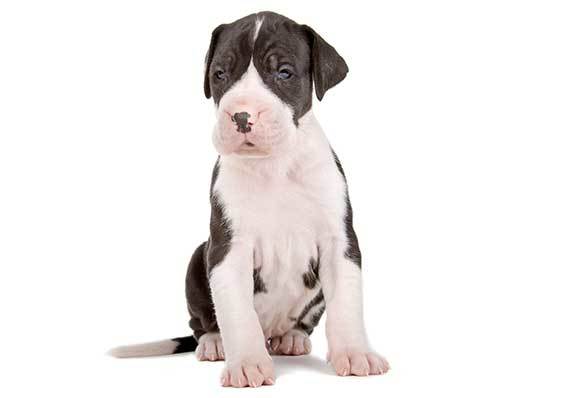
Again, a miniature version of the Great Dane seems to contradict the very essence of the dog. This dog was bred to be a large dog.
Although the average height of Irish Wolfhounds is higher than that of Great Danes, the tallest dog ever recorded is a Great Dane named Zeus who stood 44 inches tall at the shoulder.
Zeus, who died in 2014, was listed in the Guinness World Records. Coincidentally, the tallest living dog in the world is another Great Dane named Freddy. At 40.75 inches tall, Freddy towers over all other dogs and most humans. As you can see, Great Danes tend to stand tall at maturity and were clearly not meant to be miniaturized.
On the other hand, dog owners are sometimes seen with Great Danes who seem to be smaller in size than the breed standards. That’s why they are often known as Miniature Great Danes.
How Was the Miniature Great Dane Achieved?
When considering adding a Miniature Great Dane to your family, it’s important to learn as much as you can. You need to know that there are both safe and unsafe methods of creating miniature dogs.
Miniature Great Danes do not exist as a unique breed and puppies that are advertised as “Mini Great Danes” are not officially recognized by any major kennel club.
There are a few ways of creating Miniature Great Danes, so it’s important to know exactly what were referring to. These are:
1. Miniature Great Danes with dwarfism: these dogs come with some major health issues.
2. Miniature Great Danes who are bred from runts: these toys dogs also have some health concerns.
ALSO READ: Miniature Husky – Is This Mini Husky The Perfect Choice For You?
Dwarfism
You might come across puppies on other sites or in ads being labeled as “purebred Miniature Great Danes”. Unfortunately, this is not true. Such dogs are not purebred unless there is something they are hiding.
Often, Mini Great Danes have a birth defect known as pituitary dwarfism. It is a medical condition caused by a deficiency in growth hormones, thereby giving the affected dogs shorter limbs.
Some signs of a miniature dog with dwarfism include:
1. Disproportionate head in relation to the body.
2. Lack of teeth/crooked teeth.
3. Swollen abdomen or stomach.
4. Bulging eyes.
5. Hair loss.
6. Disfigured neck, back or legs.
7. Disfigured testicles.
8. Problems gaining weight.
9. Skin dryness or skin color irregularities.
10. Growing at a much slower rate than normal.
Dwarfism can lead to chronic health conditions, such as joint pain and skeletal problems. It can also cause eye disorders and spinal issues later in life.
This gene can also cause the kidneys not to develop fully, leading to kidney failure. As such, this puppy can be a very expensive one, due to regular treatment and orthopedic surgeries.
If you are getting a puppy with this DWARF gene, chances are the breeder will try to hide that from you due to the high medical expenses involved in their care.
If you suspect your Great Dane is affected by dwarfism or shows any of the above signs, make sure to take your dog to see a vet as soon as possible. Let your vet know the symptoms and how they affect your pet’s lifestyle.
Growth hormones are often a solution offered by veterinary professionals. These hormones can help grow and strengthen your pup’s stunted bones.
Growth hormones can be greatly beneficial to dwarf dogs. However, they also come with some risks, such as serious allergies and increased body weight gain.
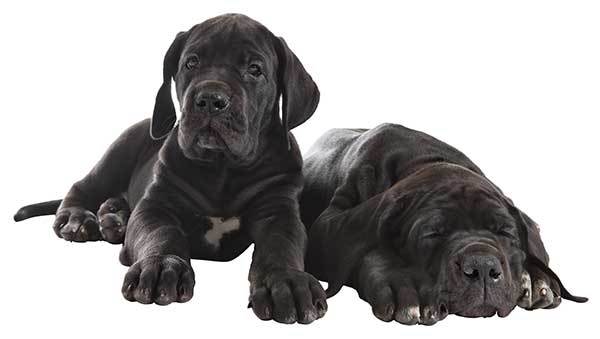
Miniature Great Danes Developed From Runts
Another way that some breeders use to create Mini Great Danes is by breeding two runts of the litter together.
Runts are naturally smaller than other puppies of the same litter. If these puppies are cared for properly, they can grow to become adult dogs.
The runts that don’t achieve the full size of the breed as adults are often used for breeding purposes in order to produce another small or smaller Great Dane.
Again, this is a dangerous approach. Generally speaking, runts struggle to survive when they are still puppies.
First of all, the runt will always struggle when competing for the milk provided by the mother dog. The runt may be too small and weak to get its fair share of milk.
Secondly, the runt is sometimes ignored by its mother simply because she notices the pup is weak or small and tries to focus on other puppies. This is natural selection and it’s all about survival of the fittest puppies in the litter.
Miniature dogs are also predisposed to becoming overweight if not provided with sufficient exercise. Since these dogs already have weak bones, becoming overweight could result in immobility.
Unfortunately, some breeders tend to disregard all these risks. If they feel they can fetch a premium price for their puppies, they will keep on creating the puppies regardless of health.
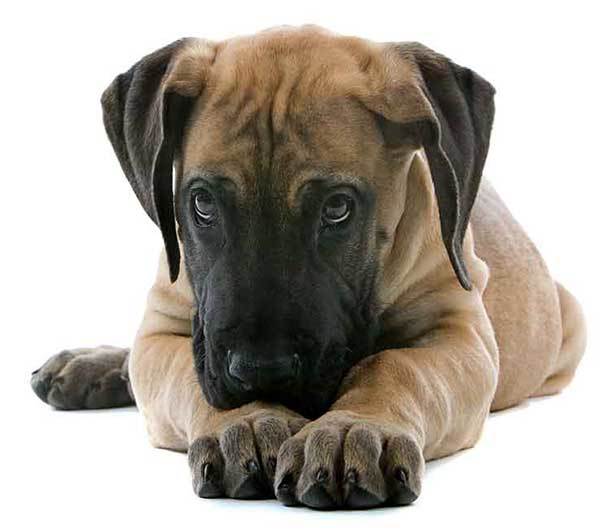
The General Appearance of a Miniature Great Dane
Miniature and standard Great Danes generally look the same except for their size.
The Mini Great Dane has a smaller and shorter body as compared to the standard Great Dane. They also have less blocky bodies and leaner muscles as compared to standard-sized Great Danes.
Great Dane Breed Appearance
As already mentioned, the Great Dane is one of the world’s largest breeds of dog. Their large size makes them impressive no matter where they are. Their long legs and giant size adds up to their elegance.
These dogs are sleek and muscular with long heads that are large in size. They also have long necks that are set high. They have medium-sized ears and black/blue or black spotted noses. The eyes are medium in size, dark and fairly deep set to add to the dog’s lively expression.
Miniature Great Dane Size, Height and Weight
As we’ve mentioned above, Mini Great Danes are considerably smaller than standard-sized Great Danes. They usually stand 26 to 28 inches tall at the shoulder.
However, since Miniature Great Danes are not a unique breed, there’s no standard height or weight. These dogs may actually look quite different.
Great Dane Size, Height and Weight
According to the breed standards, a Great Dane weighs around 120 to 140 pounds for a male and 99 to 110 pounds for a female.
When it comes to height, a male Great Dane is 34 – 36 inches tall. A female Great Dane reaches around 28 to 32 inches at the shoulder.
ALSO READ: A Complete Guide To The Miniature English Bulldog
Miniature Great Dane Behavior and Temperament
The Miniature Great Dane and the average Great Dane are identical in almost every way except for their size. Although Mini Great Danes are smaller in size, they are no less when it comes to temperament.
Just like their standard sized counterparts, Miniature Great Danes are gentle, friendly and cheerful dogs. Their relationship with their owners is one of obedience, love and loyalty.
Mini Great Danes tend to be friendly towards children and other household pets. As long as they are properly trained and socialized, the Miniature Great Dane has the potential to become a wonderful family pet.
Moreover, these dogs are known to be lap dogs, giving them the reputation of the largest lap dogs in the world. They are couch potatoes, due to their tendency towards relaxing on couches, just like standard-sized Great Danes.
Moreover, Mini Great Danes do well in smaller spaces, whether it’s your couch, lodging or car. These dogs will provide the gentle love and affection as a fully grown Great Dane.
However, they can be unreliable as watchdogs. If your Miniature Great Dane is actually mini, he might be less confident as a guard dog. Their bark can be worse than their bite, particularly if they are experiencing issues associated with teacup dogs.
 LEARN ABOUT IT: Can Great Danes Swim? Find out in this Guide
LEARN ABOUT IT: Can Great Danes Swim? Find out in this Guide
Your Miniature Great Dane’s Health
We are sure that because you love your pup, you want to take proper care of him. That’s why you need to familiarize yourself with the health conditions that might occur over the life of your Mini Great Dane.
By knowing about the health problems specific to Miniature Great Danes, you can customize a preventive health program for your dog and hopefully prevent certain predictable conditions.
Many health conditions and risks are genetic, meaning they are specific to this breed. Canine genetic experts and veterinary professionals tend to agree that the following health conditions have a significant rate of occurrence and/or impact in Miniature Great Danes.
However, that does not mean that your puppy will suffer from these problems. It simply means that he is more at risk than most other dogs. By familiarizing yourself with these conditions, you will be able to plan better for your dog’s unique medical needs.
The bad news is that the health problems for the Miniature Great Dane are numerous. Even worse news is that breeding practices can also increase the risk of these health problems. This puts this small dog at an even greater risk for certain health conditions.
Again, experts suggest that dwarf or Miniature Great Danes might not reach their full lifespan.
There’s also the possibility that the pup’s growth and development of vital organs is hindered due to abnormalities or deformities in its genetic makeup. Flawed genetic structures and genetic defects can lead to different kinds of disorders, including dwarfism in Mini Great Danes.

For the Miniature Great Dane, common health problems include hip dysplasia and Taurine-deficiency dilated cardiomyopathy (DCM).
Hip dysplasia is an irregularity of the hip joint. In most cases, hip dysplasia is either inherited from parents who suffer from the same problem or a result of the large size of the dog and increased weight on the muscles around the hip socket. Hip dysplasia can occur at birth or early in a dog’s life.
On the other hand, cardiomyopathy is a condition of the heart muscle in which the heart is unusually enlarged, stiffened or thickened. This heart disease occasionally occurs at old age in dogs.
Other common health problems to watch out for include:
1. Bloat.
2. Joint deformities.
3. Incomplete formation of vital organs such as the brain and heart.
4. Hypothyroidism.
5. Eye problems.
6. Reduced Immunity.
Fortunately for the Miniature Great Dane, his small size will mean a lower risk of joint, hip or some types of heart diseases.
In order to maintain the health of your Mini Great Dane, contact your veterinarian as soon as you notice any signs of discomfort or health issues.
Like many other miniature breeds, Miniature Great Dane puppies are a hot commodity, and many breeders are rushing to cash in on these pint-sized dogs. Sadly, this has been a huge incentive for unethical breeders to produce smaller dogs. When buying, be sure to learn as much as you can about their breeding practices.
More importantly, make sure your breeders show proof that their puppies have been health-screened for various genetic conditions.
Miniature Great Dane Lifespan
The average lifespan of a Great Dane is around 7 to 10 years. Taking proper care of a Great Dane can help prolong his lifespan.
In fact, the oldest Great Dane ever recorded was 15 years old. However, there are unverified claims of Great Danes who have lived as long as 16 or 17 years!
Since Miniature Great Danes are likely to be affected by pituitary dwarfism or particular breeding practices, their health problems can significantly reduce their lifespan. Your new pet will probably not live as long as a standard Great Dane would, and might not make it to even 6 or 7 years old.
Again, taking proper care of your Mini Great Dane can help increase his life expectancy.
Caring For Your Mini Great Dane
By now, you know all the important facts about the Miniature Great Dane. But how are you going to take care of your puppy if you actually decide to get one?
Since these tiny Great Danes are fragile creatures, caring for one requires a lot of time and effort. Moreover, you need extra money and resources, considering these cute dogs are prone to a wide range of serious health problems.
Caring for a dwarf Great Dane takes a lot of dedication as well. Already predisposed to various health problems and taking proper care of their weakened immune system requires care and attention.
So, here are some tips to help you take good care of your new ball of fluff:
1. Start housetraining your Miniature Great Dane right away
Begin by crate training to prevent accidents in your house. Get a crate that is a suitable size for your pup and place his blanket or bed inside.
Place some treats inside the crate and let your dog explore it and close the door once he starts eating them. Also, place his food in the crate during the normal feeding times and close the door when he starts eating.
Do not open the door for one or two hours to allow him to associate his crate with something nice. Nonetheless, do not keep him inside the crate for too long, or he will consider it a punishment instead.
RELATED: 6 Tips to Stop Your Dog from Peeing in the House
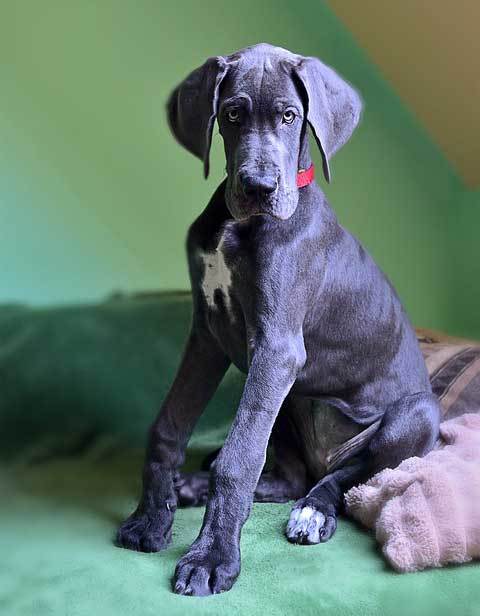
2. Start socializing your Mini Great Dane early
Introduce your Mini Great Dane to people, other canines, and other life situations to help boost your dog’s early development.
From birth to around three weeks, your puppy requires the company of the mother dog and other puppies to ensure normal dog-dog socialization.
Before he reaches twelve weeks of age, it is best to expose your Great Dane to new experiences. These include people of different ages and sizes, other pets, and the outdoors among others.
Lack of proper socialization at an early age can cause behavioral problems and even make him aggressive towards people and other dogs or pets.
Some dog owners may think that such a small pup is safe for kids since he seems gentle and innocent. Nonetheless, teacup dogs are very protective and sensitive creatures. They can be easily injured or even killed.
So a family with small kids is not the best place for these vulnerable dogs. Otherwise, proper training and early socialization is of the utmost importance.
LEARN ABOUT IT: 13 Common Dog Training Mistakes You Ought to Avoid
3. Exercise your Miniature Great Dane, but do not overdo it!
Basically, you will need a way to exercise your Mini Great Dane each day to help burn off pent-up energy and control your dog’s barking.
However, do not over-exercise your miniature dog. You need to be protective and careful with your new mini dog. These dogs are very fragile and they need your care, love and attention.
4. Groom your Miniature Great Dane
Grooming is also an important aspect of taking proper care of your Miniature Great Dane.
All Great Danes should be groomed properly. Fortunately, their coat is typically short and so they need to be brushed only a few times a week.
You should avoid bathing your mini puppy too frequently. If you wash your pup too often, it can cause skin irritation.
Moreover, the dog products you use to bathe your dog are very important. Avoid shampoos with harsh or artificial colors and fragrances. If you are not sure about any shampoo or its safety, please contact your vet.
Cleaning their ears, trimming their nails and brushing their teeth should also be an important part of your dog’s grooming routine.
LEARN ABOUT IT: 9 Tips To Clean A Dog Without A Bath
5. Feed him a healthy diet
Another thing you should do to keep your Miniature Great Dane happy and healthy is to feed him a nutritious diet. Proper nutrition can actually help prevent many of those alarming health issues we’ve mentioned above.
Since dwarfism causes weakness in dogs, organic foods are ideal for your Miniature Great Dane. Foods with extra proteins, extra fats, and organic ingredients can help build the muscle and boost the immune system of your mini puppy.
While your Mini Great Dane will still be quite large, he could still be at risk for the aforementioned health issues, including bloat, and hip problems. For that reason, it is important to feed your pup several small meals throughout the day instead of one or two larger meals.
Finding Miniature Great Dane Puppies for Sale
Miniature dogs have become extremely popular over the last few years. That’s why even the smallest dog in the world, the Chihuahua, has been miniaturized to create the so-called Teacup Chihuahua.
Like other teacup dogs, a Miniature Great Dane puppy might be born together with standard-sized Great Danes, but be considerably smaller than other puppies in the same litter.
Some breeders will call this puppy a teacup or Miniature Great Dane to make it more appealing. But that is equally misleading. Although the puppy may be small, it is not a real teacup. However, many breeders use the term “teacup” or “miniature” to describe how small the puppy is or will be as an adult dog.
In reality, every responsible great Dane lover wishes for a “real Great Dane” that is free of any health issues.
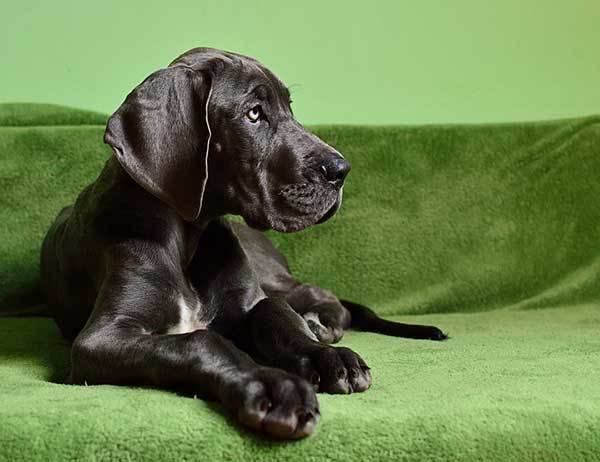
Please be extra careful when buying any miniature puppy or adult dog. Some breeders will refer to an unhealthy runt as a Mini Great Dane and put a very high price tag on it! Therefore, make sure to buy from a responsible breeder.
You should also check for yourself that the Mini Great Dane for sale and the parent dogs are kept in a safe and healthy environment. Ask to meet the mother, and if possible, the father as well. Reputable breeders are genuinely proud of their puppies and are ready and willing to produce a written health guarantee.
Good Miniature Great Dane breeders will also ask you about your lifestyle and home environment to ensure you can take proper care of the puppy.
Open your eyes towards potential red flags of a poor breeder, including the fact that such breeders always have miniature puppies available. If you think something is amiss or you are being coerced into buying, look elsewhere.
Using a reputable breeder will lower the risks of genetic conditions in your pet. This will help save you a great deal of time and money in the long run. Make sure your new Miniature great Dane puppy is vet checked immediately for your and the pet’s protection.
ALSO READ: All About the Miniature Labrador
Conclusion
Now that you have read our guide, you should have a good idea of what it means to be the owner of a Miniature Great Dane.
These dogs will love you unconditionally for taking proper care of them, but you should fully understand their health risks before you commit to this mini dog.
Owning one will have a huge impact on your life, so it’s not a decision to be taken lightly. If you have a Miniature Great Dane, make sure to consult your vet about how to provide him with a happy, healthy and comfortable life.



